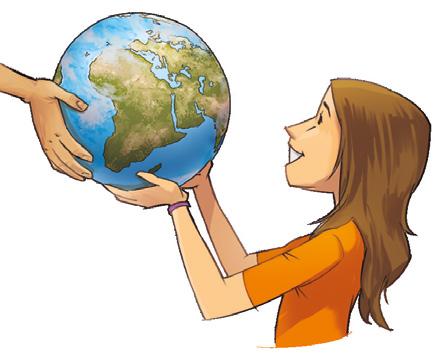
6 minute read
1 Progress or natural resources? Or both?
The latest research confirms our long-held suspicions: if the population continues to consume resources at the current rate, our planet will not be able to support our current lifestyle. As inhabitants of Earth, what can we do? Are you familiar with sustainable consumption and production? In short, it is about ensuring that economic growth does not necessarily imply environmental deterioration; it also means increasing resource efficiency and promoting sustainable lifestyles that are more respectful to our natural surroundings.
Take some time to consider the importance of changing the current model of production and consumption. Not long from now, you and your classmates will be working adults responsible for producing and consuming. The future is in your hands.

What do you think?
Have you ever wondered if your lifestyle could be harming the planet? Do you know of any natural spaces in your area that have been deteriorated by our lifestyle?
Do you think that European organisations are doing enough to solve this problem?
The context
In this unit...
Target in action
Use social media to raise awareness in your community about the importance of spreading responsible production and consumption measures.
Follow the thread!
If the world population reaches 9.6 billion people by 2050, we will need the equivalent of almost three planets to provide the natural resources needed to maintain our current lifestyle.
The relief and its modification
1
How does the topographical relief become modified?
Spain: Location and characteristics of the relief
2
Why is the relief of Spain the way it is?
The relief of the Iberian Peninsula
3
What relief forms do we find on the Iberian Peninsula?
The relief of the coast
4
Is the coast the same throughout all of Spain?
Europe: Location and characteristics of the relief

5
What is the relief of Europe like?
How does the topographical relief become modified?
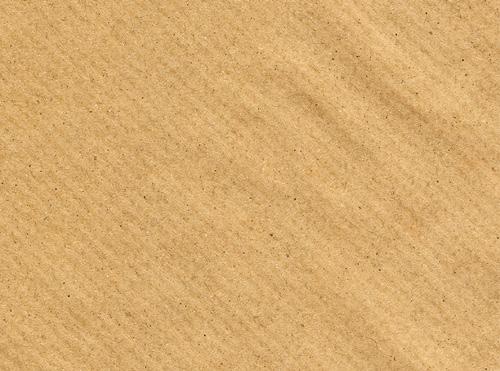
Are we humans the main reason behind the modification of the relief surrounding us?
The relief is the variety of forms (mountains, plains, valleys, etc.) on the Earth's surface. It undergoes modification due to internal and external causes.
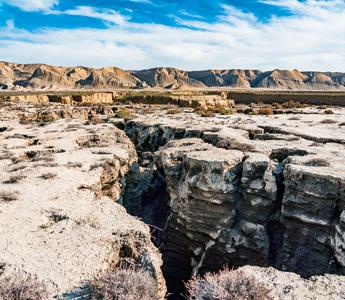
Internal causes lead to the lifting, sinking and displacement of terrain. They sometimes take place violently.
The most prominent internal causes
Earthquakes
The sudden movement of the Earth, causing tremors, cracks and displacements of the terrain and which can have a devastating impact (death, destruction of buildings, etc.). Their intensity is measured with the Richter scale.
Earthquakes that originate in the seabed. The wave increases in size as it reaches the coast. Tsunamis can cause gigantic, destructive waves that cause extensive damage to coastal towns.

1 Can the modification of the relief stemming from natural causes be compared to that provoked by human beings? Think of supporting arguments for your answer.
2 Let’s check Search for information on relief modifications due to internal causes that have occurred in Spain and Europe in recent years and create a chart for each one. Include at least the following points: type of internal cause that modified the relief, location (city/town and country), year, impact on people and nature. You can add any extra information you deem interesting.
‘Let me tell you’, you will find a summary of the unit on anayaeducacion.es
Cracks in the Earth's surface through which lava— or extremely hot molten rock—and gases from Earth’s interior are expulsed. When these eruptions occur in the seabed, lava rises to the surface and islands may be formed.
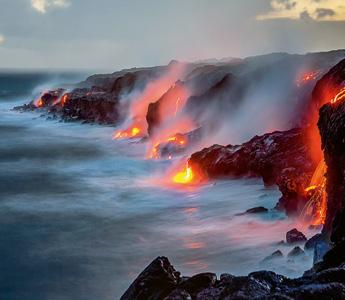
Modification of the relief due to internal causes
Type of cause
Where did it happen?
When did it happen?
Impact it had
?
Modification of the landscape
With your classmates, discuss the pros and cons of this news headline with regards to a sustainable lifestyle:
‘More than €23 billion will be invested in works to expand the high-speed network in Spain’.
External causes erode or wear away the relief, transport materials and transform it by depositing these materials or sediments in certain areas. Generally speaking, they result in slower and smoother modification of the relief.
Most prominent external causes
Atmospheric phenomena
Changes in temperature cause rocks to break due to the contraction and expansion resulting from the cold and heat, respectively.
Precipitation erodes the relief over the years and can cause more rapid change if it occurs violently. The wind wears away the rocks, giving rise to different relief forms.

Water
Water from rivers, seas and oceans erode the relief. On beaches, for example, the waves wear away the cliffs and modify the shape of the beach. Rivers erode rocks, and then transport and deposit the small fragments over and over.

Living organisms
Animals and plants slowly transform the relief by breaking the rocks with their movements and roots. Humans modify the relief more quickly and permanently. These transformations are caused by construction, mining, agriculture, etc.

Arguments in favour Arguments against ? ?
3 Make a diagram or concept map of all the internal and external causes of modification of the relief.
Language Bank
Speaking. Tell a partner about the future of your school building and its surroundings.

Writing. Write a short prediction for your school and its surroundings in 500 years’ time.
Take note!
Water is found in nature, but the infrastructure required to manage it is expensive and can contribute to modification of the relief.
Why is the relief of Spain the way it is?
What geographical characteristics lead Spain to have such a wide variety of natural resources?
the Mediterranean Sea, the Canary Islands in the Atlantic Ocean, and the autonomous cities of Ceuta and Melilla in North Africa.

To the north, the Cantabrian Sea, Andorra and France.
To the south, the Atlantic Ocean and the Mediterranean Sea.
To the east, the Mediterranean Sea.
• To the west, Portugal—which also forms part of the Iberian Peninsula—, and the Atlantic Ocean.

The five Balearic Islands form an archipelago located in the Mediterranean Sea, to the east of the Iberian Peninsula.
The seven Canary Islands form an archipelago washed by the Atlantic Ocean, quite far south of the mainland and close to Africa.
Balearic Islands
This archipelago is made up of the islands of Majorca, Minorca, Ibiza, Formentera and Cabrera and other smaller islands, such as Sa Dragonera, Illa Conillera, etc.
Canary Islands
This archipelago is made up of seven islands with their own administration: La Palma, El Hierro, La Gomera, Tenerife, Gran Canaria, Lanzarote, Fuerteventura, as well as the island of La Graciosa and the islets
Alegranza, Lobos, Montaña
Clara, Roque del Este and Roque del Oeste.
What are the characteristics of the relief of Spain?

The relief of Spain is widely varied, and the average elevation is 650 m. It is the country with the second highest average altitude in Europe, following Switzerland.
The peninsular relief features large mountain ranges, a large central plateau—which occupies much of the territory—, and valleys.
The relief of the Canary Islands is volcanic in origin, and, therefore, different from the Iberian Peninsula.
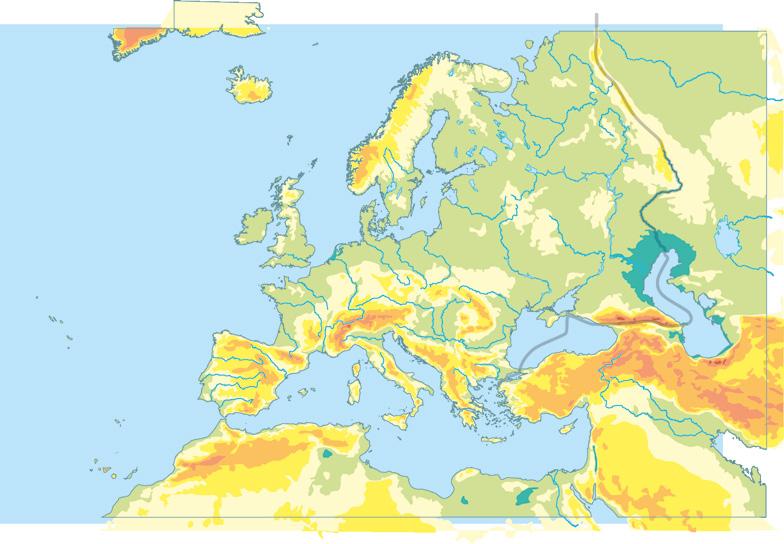
The relief of the Balearic Islands is an extension of the Baetic Cordillera of the Iberian Peninsula.
Maritime accidents involving large vessels transporting merchandise can have disastrous consequences for marine resources if there are fuel spills.
1 Decide which of these statements are true and correct the false ones.
a) Spain is located in the Southern Hemisphere.
b) The Spanish territory is made up of part of the Iberian Peninsula, two archipelagos and two cities in North Africa.
c) Spain is the fourth highest country in Europe.
d) The Spanish coasts are only washed by the Mediterranean Sea.
2 Draw a map of Europe in your notebook and highlight Spain. In which part of Europe is Spain located?
the necessary infrastructure for air, sea and land transport, among other things. They want to set up a highway communication channel to transport medicine in high mountain areas.
Look at the legend of the map of Spain and mark the three highest points where their intervention would be necessary.
What relief forms do we find on the Iberian Peninsula?
What parts of the relief must we bear in mind to conduct business on the Iberian Peninsula responsibly?
Spain has a large inner plateau known as the Meseta Central that constitutes approximately 45% of the peninsular territory. The remaining landforms are organised into two large groups around it: on the one hand, landforms inside and bordering the Meseta, and on the other, landforms outside the Meseta.
Meseta and interior landforms
Location: This group includes Castilla y León, Castilla-La Mancha, Madrid and Extremadura.
Characteristics: A high plain with an average elevation of 650 meters.
The mountain systems in the interior of the Meseta are: the Central Sierra and the mountains of Toledo.
Landforms bordering the Meseta
The landforms that border the Meseta are: the mountains of León, the Cantabrian Mountains, the Iberian Cordillera and the Sierra Morena.
Central Sierra
Location: Centre of the Meseta.
Characteristics: This mountain chain is approximately 600 km long. It splits the Meseta in two parts: the Northern Sub-meseta, occupied by the Duero valley, and Southern Sub-meseta, which includes the Tagus and Guadiana valleys.
Major mountain ranges: Somosierra, Guadarrama, Gata and Gredos, where the highest peak, Almanzor, is located.


Mountains of Toledo
Location: Southern Sub-meseta.
Characteristics: These mountains have a lower altitude than the Central Sierra and they separate the Tagus (to the north) and the Guadiana (to the south) valleys.
Major mountain ranges: San Pedro and Guadalupe, where the highest peak, Villuercas (1,601 m) is located.






